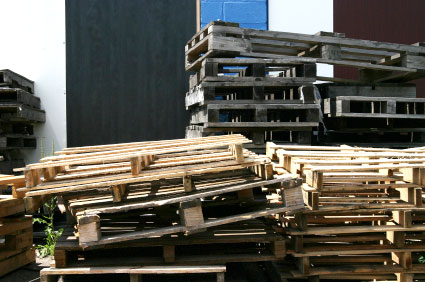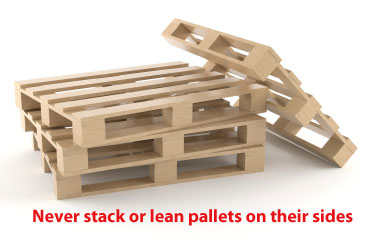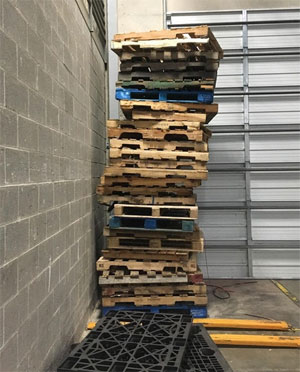How to Store Stacks of Empty Pallets
Learn how to safely deal with empty skids in your warehouse

Most distribution and manufacturing operations deal with empty pallets. Sometimes, a lot of them.
Empty pallets take space you could use for something else as they clutter your receiving area. Sometimes they’re splintery, with nails protruding from the sides ready to bite a passerby. People re-use their pallets, holding onto them for a period of time until they’re used for an outbound shipment. But while they’re in your facility, they can eat space, potentially injure people, and generally cause trouble.
Never stack pallets on their sides

Why would you ever stack empty pallets vertically? They don’t take up any more space than pallets stacked the right way–and they’re far less stable.
People sometimes wedge a couple of vertical pallets between stacks of horizontally stacked ones to get them out of the way. Or they’ll lean them against a building column or the side of a rack upright. They’ve just set a trap that can injure someone. When the stacks start being pulled, those vertical pallets–sometimes with nails, sometimes with splinters, always heavy enough to injure–are in danger of tipping over.
This can result in serious injuries and the litigation that accompanies those injuries. In this case, it may have been truck drivers or other outsiders who stacked the pallets wrong – another thing you have to watch.
OSHA on vertical pallets
- While there is no specific OSHA code pertaining directly to vertical pallet stacking, inspectors sometimes cite companies who engage in it.
- The issue may fall under OHSA 1926.25(a), under housekeeping.
- If a practice creates a potential safety hazard the rule can be applied to any operation even if not specifically covered.
- It’s a generally acknowledged safety problem, abut easily fixed with process and training.
Never stack pallets on their sides. Make it a company policy to never stack pallets on their sides, and never lean them against anything. The safe way is flat on the bottom, every time.

Never stack pallets too high
According to OSHA standard 1917.14, “Cargo, pallets and other material stored in tiers shall be stacked in such a manner as to provide stability against sliding and collapse.”
This covers a lot of ground, including the way they are stacked (haphazardly, in mixed sizes, etc.). The main focus here should be on height.
How high is too high? When a standard GMA pallet is 48″ x 40″, and has a height (which varies) of 5″ to 7″ from floor to top of deck, each pallet can weigh 55 pounds. This means it’s a common sense standard, and that you should also look at nearby traffic patterns, particularly at people.
The insurance industry prefers a modest six foot stack, which works better if you are handling the pallets manually. It’s also recommended that pallet stacks higher than six feet should be protected by automated sprinkler systems (per National Fire Protection Association (NFPA) 13, Standard for the Installation of Sprinkler Systems.).
Fire code compliance
Your pallet storage plan must address fire code compliance and risks. Aside from its 6-foot recommendation, NFPA also recommends that you shouldn’t stack pallets within 25 feet of other commodities. This makes mixing inventory on racks with empty pallets problematic, as well as other methods like floor storage. NFPA also advises that empty pallets stored outside whenever possible.
Plastic pallets are even riskier. Those should be stacked in quantities no higher than four total pallets. NFPA also advises specially designed sprinkler systems for plastic pallet storage areas due to their flammable nature.
Read more: Pallet Racks, Sprinkler Systems and Warehouse Fire Precautions
Never stack pallets crookedly, or in varying sizes

Poor pallet stacking could be characterized as the world’s most dangerous Jenga game; if your pallets are in poor condition, if they aren’t uniform in size, and if they are stacked haphazardly, they can tumble or break. At 55 pounds a pallet, that’s an injury waiting to happen, even if the pallets are in great condition. If they aren’t, 55 pounds driving a bent nail or splintery edge can be even worse.
The point: stack them in very straight stacks, and stay at relatively low heights. It’s better to eat a bit of floor space than it is to create a safety hazard. You can also employ pallet stacking frames or stacking racks to help stabilize them.
Pallet stacks should be separated by at least eight feet, and should be separated from general inventory by 25 feet.
Use the vertical cube
One way to deal with a mass of pallets without covering your staging areas in stacks is to use dead space. While you typically don’t have the rack space to store idle pallets, many facilities have had success with over-dock-door pallet storage racking. This is often unused space, and can be converted to pallet storage with specialized racks.
Never keep or re-use damaged pallets
Damaged pallets are inherently unsafe for a number of reasons:
- They are also a factor in product damage incidents, as product can more easily fall from them.
- This also endangers people who may work in rack aisles beneath damaged pallets.
- This can also contribute to rack collapses by creating imbalances on your rack beams.
- When a pallet is splintered on its ends, it has a good chance of cutting or scraping workers who handle it. When it has protruding nails or fasteners, it’s even more unsafe.
- If it’s missing boards, stringers, or other components, it can break under a load, or while being transported by forklift.
- It can tilt or lean while stored in racks. That’s unsafe for workers, and can result in a spilled pallet and lots of inventory damage.
NOTE: As with all safety advice on this website and in our literature, this is general in nature, and is derived from what are believed to be reliable sources. Please consult a safety engineer for specifics regarding safe storage of pallets or any other material in your facility. This is an article for informational purposes and may not cover other issues relating to safe pallet storage. For fire code and other safety compliance, refer to local regulations and safety experts.
Related articles:
- A Guide to Stacking, Storing and Handling Bulk Materials
- 5 Common Mistakes People Make with Pallet Racks
- A Rule of Thumb: Rack Height to Depth Ratio
- Video: safer, straighter pallet restacking
Scott Stone is Cisco-Eagle's Vice President of Marketing with 35 years of experience in material handling, warehousing and industrial operations. His work is published in multiple industry journals an websites on a variety of warehousing topics. He writes about automation, warehousing, safety, manufacturing and other areas of concern for industrial operations and those who operate them.



